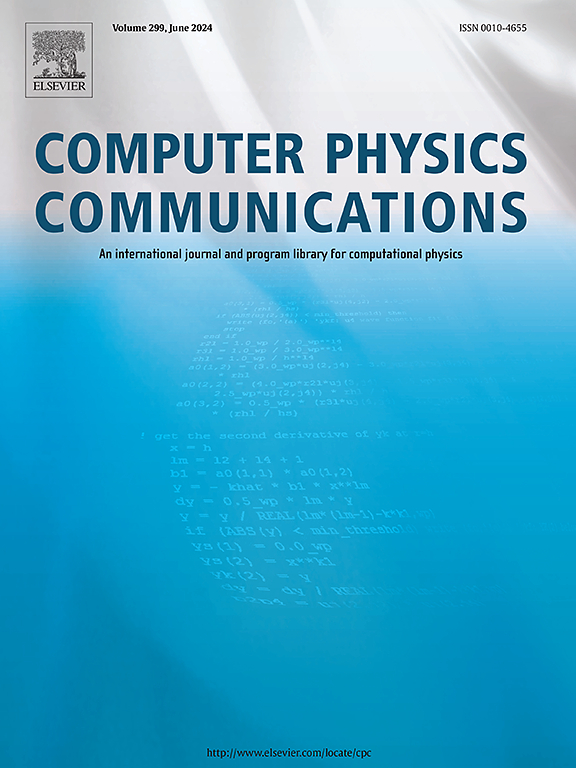Accurate plasma boundary calculation using linear triangular finite elements
IF 3.4
2区 物理与天体物理
Q1 COMPUTER SCIENCE, INTERDISCIPLINARY APPLICATIONS
引用次数: 0
Abstract
This paper presents a novel method for accurately tracing magnetic field lines. This procedure is of particular interest for axisymmetric nuclear fusion devices. The design of the plasma facing components in a tokamak strictly depends on the Scrape-Off Layer (SOL), a thin region of open field lines through which charged particles and energy flow out from the plasma core to the solid walls with a huge heat flux. The power exhaust issue is among the top priorities in the European Fusion Roadmap, hence the determination of the plasma boundary and SOL with a high accuracy is essential. Existing equilibrium codes using finite element formulations with linear triangles of mesh size provide a piecewise constant magnetic flux gradient, resulting in coarse accuracy of the field lines in the SOL, with an error of order , especially near the X-point where the flux gradient approaches zero. The proposed procedure is based on a method introduced in 2023, which achieves continuity and a convergence rate of order for the magnetic flux gradient too. The magnetic poloidal flux is then approximated with a piecewise polynomial function of second or third degree in the triangles. A more accurate evaluation of the plasma boundary and SOL field lines is obtained, particularly near the X-point, which is no longer constrained to be a mesh node. The method has been successfully tested in two cases with available analytical solutions. It has also been used as a post-processor for the flat top configuration of the DTT tokamak obtained with the free boundary CREATE-NL+ equilibrium code. For a given accuracy, the computational cost of the procedure is significantly lower than alternative methods relying on finer first order discretization or techniques using triangular C1 finite elements.
用线性三角形有限元精确计算等离子体边界
本文提出了一种精确跟踪磁力线的新方法。这个程序对轴对称核聚变装置特别有意义。托卡马克中面向等离子体组件的设计严格依赖于刮擦层(SOL),这是一层薄薄的开放场线区域,带电粒子和能量以巨大的热流从等离子体核心流出到固体壁上。功率排放问题是欧洲聚变路线图中最优先考虑的问题之一,因此高精度的等离子体边界和SOL的确定至关重要。现有的平衡代码使用网格大小为h的线性三角形的有限元公式,提供分段恒定的磁通量梯度,导致SOL中磁力线的精度较差,误差为O(h)阶,特别是在磁通量梯度接近零的x点附近。该方法基于2023年提出的一种方法,实现了磁通梯度的连续性和O(h2)阶的收敛速度。然后用三角形中的二阶或三次分段多项式函数来近似磁极通量。获得了更准确的等离子体边界和SOL场线的评估,特别是在x点附近,它不再被限制为网格节点。该方法已在两种情况下用可用的解析解成功地进行了测试。它也被用作用自由边界CREATE-NL+平衡码获得的DTT托卡马克平顶构型的后置处理器。对于给定的精度,该程序的计算成本明显低于依赖于更精细的一阶离散化或使用三角形C1有限元技术的替代方法。
本文章由计算机程序翻译,如有差异,请以英文原文为准。
求助全文
约1分钟内获得全文
求助全文
来源期刊

Computer Physics Communications
物理-计算机:跨学科应用
CiteScore
12.10
自引率
3.20%
发文量
287
审稿时长
5.3 months
期刊介绍:
The focus of CPC is on contemporary computational methods and techniques and their implementation, the effectiveness of which will normally be evidenced by the author(s) within the context of a substantive problem in physics. Within this setting CPC publishes two types of paper.
Computer Programs in Physics (CPiP)
These papers describe significant computer programs to be archived in the CPC Program Library which is held in the Mendeley Data repository. The submitted software must be covered by an approved open source licence. Papers and associated computer programs that address a problem of contemporary interest in physics that cannot be solved by current software are particularly encouraged.
Computational Physics Papers (CP)
These are research papers in, but are not limited to, the following themes across computational physics and related disciplines.
mathematical and numerical methods and algorithms;
computational models including those associated with the design, control and analysis of experiments; and
algebraic computation.
Each will normally include software implementation and performance details. The software implementation should, ideally, be available via GitHub, Zenodo or an institutional repository.In addition, research papers on the impact of advanced computer architecture and special purpose computers on computing in the physical sciences and software topics related to, and of importance in, the physical sciences may be considered.
 求助内容:
求助内容: 应助结果提醒方式:
应助结果提醒方式:


